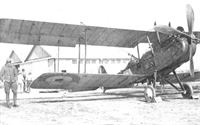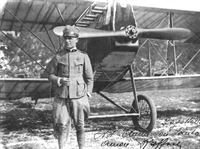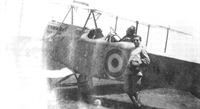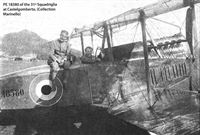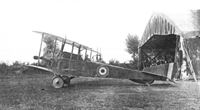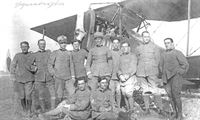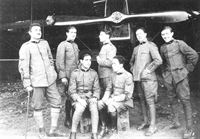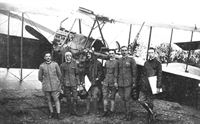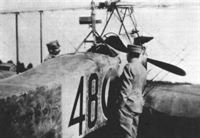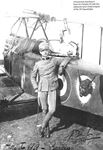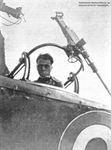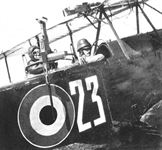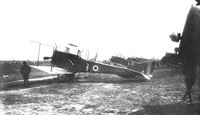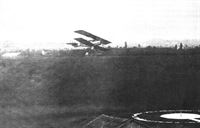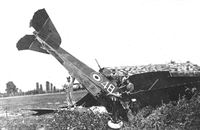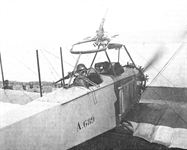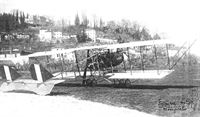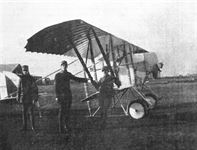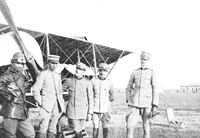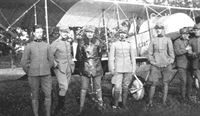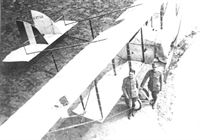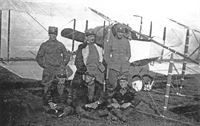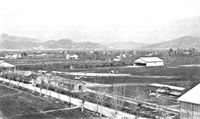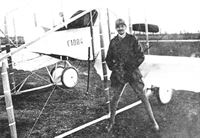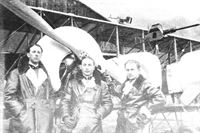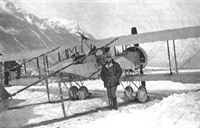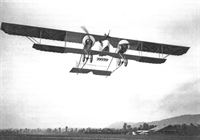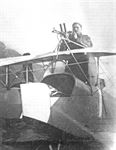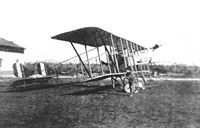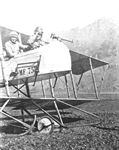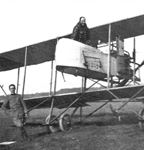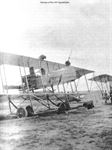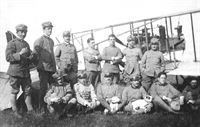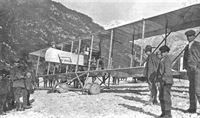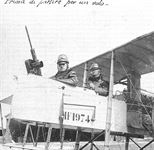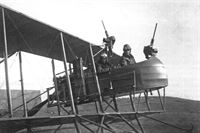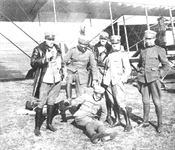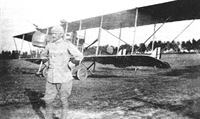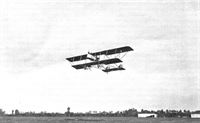Книги
Aeronaut
R.Gentilli
Italian Aviation Units in the First World War. Vol.2
353
R.Gentilli - Italian Aviation Units in the First World War. Vol.2 /Aeronaut/ (2)
An R.E.8 of No. 34 squadron, Royal Air Force, made available for the observers of the 38a Squadriglia.
SP.3s of different production batches at San Pietro in Gu airfield; in the background there are French Sopwith 1 A2s.
SP.3 4531 of the 22a Squadriglia captured at Campoformido. In front of it there is a line of destroyed French Sopwith 1A2 (1 1/2 Strutters) and behind, some Albatros fighters.
The remains of Sopwith Camel B2366 that crashed at Castello di Godego on 6 June 1918 with the death of Lieut. N. Marchant.
The Ansaldo A.1 Balilla scored its only victory in the war with the 70a Squadriglia. Here the pilot is ten. Eleuteri. (Archive Roberto Bassi)
At the end of the war, Italian fighter squadrons were powerful units, fielding 18 fighters, with the plan of having 36 pilots and 36 planes in 1919; here the 70a Squadriglia with a mix of Spads and Hanriots and, first from the left, a single Balilla.
SVA 14798 was assigned to the 59a Squadriglia. It was one of about 250 built by the AER factory at Orbassano, near Turin.
Cpr. Francesco Cicalo with a SVA that shows both the flag of St. George, insignia of the squadron, and the black cat of the 2a Sezione SVA.
Writing the squadron number on the fin of airplanes was uncommon, but useful for future researchers.
A line-up of SVAs of different versions of the 58a Squadriglia. The enlarged radiator that was used after the war here appears for the first time.
Cap. Raffaele Martinetti Bianchi, here in front of an Ansaldo A.5, accomplished some relevant flights in the immediate post-war years.
An SVA of the 31a Squadriglia after the war; the first man is commander Capuzzo, the fourth one is brig. Giovanni Zeppegno who was killed flying for d'Annunzio in Fiume in 1919.
A Czech crew, pilot serg. Jindrich Brajla and ten. Mirko Dostal, on 11 January 1919 flew this SVA 10 from Ganfardine to Prague. It carried as insignia the twin-tailed Lion of Bohemia.
According to documents, Pomilio PE 7839 flew with the 61a Squadriglia, but its triangle insignia seems the one of the 33a Squadriglia. (Archive Angelo Emiliani)
The beautifully decorated PE 18502 of the 28a Squadriglia; it is a late production plane, fitted with a Scarff ring.
A late-production Pomilio PE, 18508, showing the new insignia of the 22a Squadriglia, a white cannon.
A late production PE of the 36a Squadriglia, with two Lewis guns on the Scarff ring. The pilot is s.ten. Edoardo Garavoglia.
A Pomilio PE and the squadron insignia, with the whole rear fuselage and tail painted in a light color.
A lieutenant standing in front of a Pomilio PE with the elaborate lynx's head insignia of the 39a Squadriglia.
Pomilio PEs of the 26a Squadriglia lined up at Padua airfield for a patriotic ceremony show the insignia of the man pointing his finger.
Pomilio PE 14822 of 48a Squadriglia smashed on 30 August 1948, with the crew of serg. Rongioni and ten. Bertolotti. (Cela - Europeana)
The wing of a PE with damage from enemy fire, 6 October 1918; pilot serg. Giacomelli, observer ten. Cela. (Cela - Europeana)
An Aviatik of the 72a Squadriglia, with a puzzling serial number, 1593, that belongs to a batch of SAML S.1s. (Archive Caliaro)
The SAML of cop. Pinna and s.ten. Moccafiche that on 3 August 1917 crash landed on the Adamello glacier. (Archive Fiorenzo Longhi)
SIA 7B of the 22a Squadriglia and, in the background, SAML of the 114a Squadriglia at Casoni. (Archive Caliaro)
SIA 7B 6035 of the 22a Squadriglia, behind it a SAML of the 114a Squadriglia can be seen. (Collection Lepore)
The observer tenente Pietro Ottelli in Farman Colombo 1978 at Castenedolo. (Courtesy Pierluigi Ottelli)
This Farman Colombo of the 29a Squadriglia is decorated with the white halberd on a red shield of the city of Trieste.
Farman Colombo 2666 of the 29a Squadriglia showing some form of emblem with two crossed cannons on the nose.
Farman MFC 2687 of the 50a Squadriglia. The pilot in the center is Amedeo Mecozzi, later a theorist of air warfare, opposed to the ideas of Giulio Douhet of strategic bombing and favoring ground attack tactical aircraft.
Farman Colombo MFC 2692 of the 50a Squadriglia. The MFC was an honest airplane that saw widespread use.
MFC 2692; the MFC shared the same wings with the more common Maurice Farman type 1914, as it was called in Italy.
An emergency landing of Farman Colombo 2639 of the 46a Squadriglia, possibly the accident of 17 August 1917. (Archive Caliaro)
An SP.2, 346?, of the 40a Squadriglia after an emergency landing on the bed of the Torre river, with pilot serg. Ruffinengo of the 40a Squadriglia and ten. Tuzi of the 111a Squadriglia, May 1917.
SP.2 3512 of the 21a Squadriglia taking off for its final mission, 16 June 1917. (Archive Franz Selinger)
The rudder and fuselage serial number of SP.2 1907 are preserved in the Museum of Science and technique of Milan. (Courtesy Marco Gueli)
SP.3 4512 showing the insignia of the 24a Squadriglia, an elaborate shield of Savoy, in the rugged terrain of Cavazzo Carnico.
SP.3 4531 of the 22a Squadriglia captured at Campoformido. In front of it there is a line of destroyed French Sopwith 1A2 (1 1/2 Strutters) and behind, some Albatros fighters.
Savoia Pomilio SP.3 4536 shot down on 23 August 1917, with its crew, serg. Malaspina and ten. Mazzarino, captured. (Archive Zdenek Skolil)
SP.3 4605, in the front cockpit is ten. oss. Eliso Panizzera. With this disposition, the airplane had no defense against attacks from the rear.
SP 4624 with a beautiful decoration of stars and the motto "Unguibus et rostris" (with claws and beak). In the front cockpit is col. Gilbert de Winkels, chief of the aviation command of the 1a Armata.
SP.3 4658 with the new insignia of the man pointing his finger, taken from a book popular at the time: "Come ti erudisco il pupo" (how to educate your kid).
Savoia Pomilio SP.3 4659; this airplane was shot down on 28 January 1918 with the death of its crew. A triangle was the insignia of the 33a Squadriglia.
The aviators of the 26a Squadriglia. This photo was published in a magazine, so all the names are known; from the left: serg. Gaggero, sold. Cappellini, ten. Bonino, ten. De Notti, doctor Denza, s.ten. Aldi, ten. Manzini, s.ten. Cebrelli, cap. Lioce, cap. Bianchi, s.ten. Marangoni, ten. Contini, serg. Graziani, m.llo Radicchi, serg. Pasquali.
SP.3s of different production batches at San Pietro in Gu airfield; in the background there are French Sopwith 1 A2s.
SP.3 6719, the airplane in which commander Scarioni lost his life. A searchlight is installed in the nose. (Collection De Vicari)
The airfield at Castello di Godego; in the forefront there are French Nieuports, Sopwiths and Dorands, in the top left there is the Italian part of the field, where a Caudron G.4 of the 48a Squadriglia and an SP.3 of the 27a Squadriglia can be seen.
A captain, probably Jannoni Sebastianini, checks an SP written off during the transfer of the squadron from San Pietro al Campo to Santa Giustina on 28 June 1917; the emblem of the SIA factory can be seen.
Pomilio SP.4 was delivered to the Royal Air Force at Villaverla on 16 June 1918. The second man from the right is the Canadian ace William G. Barker. (Archive Caliaro)
On 14 June 1918 SP.4 #5253 crashed due to an engine failure with the crew of serg. Attilio Gasperini, s.ten. oss. Alberto Cassol, and Arturo Marzari. S.ten. Cassol was killed.
SIA 7B 5930 of the 35a Squadriglia. This airplane was lost, captured by the Austrians, on 15 January 1918.
SIA 7B of the 32a Squadriglia, the one in the back, serial 5998, crashed on 22 June 1918 killing its crew.
SIA 7B 6035 of the 22a Squadriglia, behind it a SAML of the 114a Squadriglia can be seen. (Collection Lepore)
Sergente maggiore Camillo Sirigatti was a gallant pilot, who was awarded two Silver Medals. Here he is in front of a SIA 7B.
SIA 7B of the 22a Squadriglia and, in the background, SAML of the 114a Squadriglia at Casoni. (Archive Caliaro)
About 170 SIA 7B2 were built, and many reached the front before all SIAs were grounded. It offered better frontal vision to the pilot than the SIA 7B1, but it was just as unsafe.
Although a large number of SIA 7B2 reached the front, photographs of this version are almost non-existent. This is crashed SIA 7B2 8395. (Archive Paolo Monti)
The 29a Squadriglia was equipped with the excellent French Breguet 14 A2, too late to take part in the war.
Carlo Magno Grandinetti flying into battle dressed like a Native American to scare the Austrians into believing that the United States had already entered the war.
A Caudron G.3 of the 42a Squadriglia with some personal markings: the usual Happy Hooligan and an eagle.
Caudron G.4 2062 of the 43a Squadriglia; behind it is a Nieuport 17 of the defense flight attached to this unit. (Archive Achille Vigna)
Three outstanding pilots of the 48a Squadriglia: Finzi, Massoni, and Palli, who all were later assigned to the crack 87a Squadriglia.
Apparently obsolete, the Caudron G.4 was appreciated, as it was particularly effective in a mountain environment. (Museo del Risorgimento Vicenza)
Three Caudron G.4s of the 2a Sezione of the 48a Squadriglia detached at Feltre airfield in June 1917. (Europeana)
The airfield at Castello di Godego; in the forefront there are French Nieuports, Sopwiths and Dorands, in the top left there is the Italian part of the field, where a Caudron G.4 of the 48a Squadriglia and an SP.3 of the 27a Squadriglia can be seen.
The airfield at Castello di Godego; in the forefront there are French Nieuports, Sopwiths and Dorands, in the top left there is the Italian part of the field, where a Caudron G.4 of the 48a Squadriglia and an SP.3 of the 27a Squadriglia can be seen.
A Farman of the 47a Squadriglia at Dudular; behind it there are French Farman 40 two-seaters and Nieuport fighters.
A Hanriot of cap. Omizzolo, commander of the 72a Squadriglia with personal marking on the rudder: a shield with the eagle of Trento and the lion of Venice, and the letters HD 1916J3. (Archive Giorgio Catellani)
Ten. Archibugi in a shining Hanriot, with a little flag attached to the wing strut. (Archive Giorgio Catellani)
The Hanriot HD.1s of the 72a Squadriglia, the first one is French-built c/n 542, carrying the Italian serial number 11432.
Another line of Hanriots, showing different placement of Lion of St. Mark insignia. The first one has the finish of a Macchi-built one, but its rudder shows French style stencils. Its serial number, 6139, gives no clue, as it belongs to a batch that was assigned indifferently to French- and Italian-built machines.
The 72a Squadriglia went on flying the Hanriot until the mid-Twenties, now having as insignia a prancing black lion.
Pilots of the 70a Squadriglia in front of Hanriot 6252 of ten. Guglielmotti, in the center, showing on the fin the collar tabs of the Bersaglieri troops.
The Hanriot 11411 of cap. Flaminio Avet at Gazzo, 28 October 1918. On the top wing, besides the individual number 3 and two diagonal bands, there are little roundels over the holes of enemy bullets.
A long line of Hanriots of the 70a Squadriglia; the first one carries as personal marking the flag of Sardinia, with a red cross and four heads of blindfolded Moors.
The funeral of cap. Luigi Bourlot, on the left there is Hanriot 13214 of the 80a Squadriglia. (Archive Scroccaro)
At the end of the war, Italian fighter squadrons were powerful units, fielding 18 fighters, with the plan of having 36 pilots and 36 planes in 1919; here the 70a Squadriglia with a mix of Spads and Hanriots and, first from the left, a single Balilla.
Austrian soldiers posing with the captured Hanriot of the 72a Squadriglia, that now has a repaired fin and Iron Cross markings. (Archive Caliaro)
Swiss policemen guard the Farman of serg. Alberto and cap. Giammarco that landed in Switzerland on 23 June 1916. (Archive De Antoni)
Airmen of the 27a Squadriglia with Farman 771; the second is Carlo Adamoli, the third is Roberto De Anna, a volunteer from Mexico. (Archive Caliaro)
Farman 787 of the 27a Squadriglia with the Mexican pilot De Anna, still with the rank of corporal. (Archive Caliaro)
The observer ten. Luigi Premoli, a gallant airman, decorated with two Silver medals. His collar tabs indicate a cavalry Regiment.
Serg. Michele Allasia, second from the right, was initially a pilot at the 37a Squadriglia, then an ace with the 77a Squadriglia. He died in the crash of a SVA on 20 July 1918.
M.llo Pancani with a late production Farman MF in dark finish and with a drop shaped tank over the top wing.
Farmans of the 30a Squadriglia; the first one seems to have some dark color on wings and tailplanes, while the other ones are in natural linen.
A Farman of the 47a Squadriglia at Dudular; behind it there are French Farman 40 two-seaters and Nieuport fighters.
The fuselage of Farman 857, shot down on 4 July 1916, exhibited for the population. The two men in the center seem to be the Italian crew in captivity. (Archive Zoltan Czirok)
Being billeted at Bergamo, a medium-sized town, the airmen of the 37a Squadriglia were able to have their own postcards printed.
Macchi-built Ni. 11 1685 of ten. Ruffo di Calabria, armed with a Colt machine gun, with the first version of his skull and crossbones insignia
Ten. Sabelli in Nieuport 11 1766 of the 71a Squadriglia at Cascina Farello. (Archives Paolo Varriale)
Francesco Baracca and his mechanics in front of a Nieuport 11; the Italian colors of green and red are painted under the upper wings.
Sergeants Dino Menegoni and Edoardo Olivero, from Argentina, two goods pilots of the 71a Squadriglia, with an artillery sergeant.
Cap. Giorgio Chiaperotti in a brand-new French Nieuport 17 at Villaverla.The photo is signed with a dedication to his Group commander. (Archive De Antoni).
Italian-built Nieuport 17 3647 of the 71a Squadriglia at Villaverla.
A Macchi-built Nie.17, presumably Vickers-armed. The presentation of the serial number, Ni.3647, is typical of Italian practice, and it is noteworthy that the roundels on the upper wing do not extend over the ailerons.
A Macchi-built Nie.17, presumably Vickers-armed. The presentation of the serial number, Ni.3647, is typical of Italian practice, and it is noteworthy that the roundels on the upper wing do not extend over the ailerons.
French-built Nieuport 17 3123 and a Spad of 71a Squadriglia at Villaverla. The pilot is the gallant serg. Francesco Tola, who earned two Silver Medals.
Three French-built Nieuport 17s, the first one of serg. Poli, the second one, with skull and crossbones, of ten. Ruffo, and the third one, with the prancing horse, of cap. Baracca.
Caudron G.4 2062 of the 43a Squadriglia; behind it is a Nieuport 17 of the defense flight attached to this unit. (Archive Achille Vigna)
At the end of the war, Italian fighter squadrons were powerful units, fielding 18 fighters, with the plan of having 36 pilots and 36 planes in 1919; here the 70a Squadriglia with a mix of Spads and Hanriots and, first from the left, a single Balilla.
An early Spad 7, without shutters for the radiator. The technician wears an arm band indicating that he is a civilian assigned to military service. (Archive Caliaro)
French-built Nieuport 17 3123 and a Spad of 71a Squadriglia at Villaverla. The pilot is the gallant serg. Francesco Tola, who earned two Silver Medals.
The playful photographs of the airmen of the 25a Squadriglia are proof of the high morale and esprit de corps of this outstanding unit.
A Voisin with Isotta Fraschini engine of 25a Squadriglia with a full load of bombs and a Fiat and Villar Perosa guns. (Archive Caliaro)
Voisin 2094 with Canton Unne engine of the 35a Squadriglia. The airmen are holding 162-mm 50 pound bombs. (Archive Caliaro)
A group of high officers visits the 25a Squadriglia; the Voisin behind them carries no gun, but in front of the cockpit there is a good luck charm doll.
Commander Calleri Di Sala and other airmen in front of a late-production Voisin, serial 208?, with Canton Unne engine. (Archive Caliaro)
Massimo Adolfo Vitale, a Jew, was a veteran of the Libyan war. Later he was commander of the flying school at Gioia del Colle, using Voisins, and then creator of the Italian Air Force in the colonies of Somalia and Eritrea. He left Italy in 1938, returned in 1945, and created a network for the search of information on Italian Jews victims of the Holocaust.
S.ten. Luciano Bianchi flew Gabriele d'Annunzio at the 25a Squadriglia. In the cockpit of the Voisin there is a bullet hole with the caption "Nabresina 13 January 1916".


